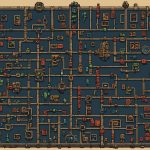Introduction to Machine Learning in Game Design
Machine Learning is revolutionising game design, offering novel approaches to creating dynamic and unpredictable environments. This technology enables developers to craft games that adapt to player actions, providing an engrossing experience. In particular, roguelike games heavily benefit from this technology, allowing procedurally generated worlds that are never the same.
Over recent years, roguelike games have evolved significantly. Traditionally characterised by their permadeath mechanics and randomly generated levels, they now incorporate machine learning for more nuanced level design. This evolution elevates not just the replayability but also the overall enjoyment of these games.
Also to discover : Revolutionizing Gameplay: Cutting-Edge Methods for Flawless Voice Recognition Integration in Storytelling Video Games
One of the fundamental aspects in this genre is level creation. By employing machine learning, game designers can ensure that every new level feels fresh and engaging, enhancing the player’s experience significantly. The synergy between technology and game design fosters a more immersive environment, where each game session becomes a new adventure.
Thus, the intersection of machine learning and roguelike games marks a transformative phase in game design, paving the way for more tailored and interactive gaming experiences. It’s a promising direction with the potential to redefine how we engage with games.
In parallel : Mastering the Challenges: Key Hurdles in Game Development for Hybrid VR and AR Platforms
Machine Learning Techniques for Level Generation
Procedural generation is a key component in modern roguelike games, fostering replayability and unique experiences. By utilising various AI techniques, developers create levels that are both challenging and engaging. The primary benefit is the generation of levels that adapt to different player styles and preferences, ensuring that no two gameplay experiences are identical.
Among the AI techniques applied to level creation, neural networks and genetic algorithms stand out. Neural networks can learn and predict player behaviour, crafting levels that match skill and style. By analysing gameplay patterns, they adjust difficulty in real-time, keeping players on their toes. Genetic algorithms, on the other hand, simulate evolutionary processes, selecting the best level designs after multiple iterations to offer a smooth yet captivating experience.
Many popular roguelike games have successfully implemented these techniques. Titles like “Dead Cells” and “Enter the Gungeon” illustrate machine learning’s potential in enhancing game design. They use AI to create environments that react to player actions, adding depth and complexity to each playthrough. Such implementations underscore the synergy between procedural generation and AI techniques, setting a benchmark for future game developments in the genre.
Practical Applications of Machine Learning in Roguelike Games
Let’s delve into how game development has evolved through the practical applications of machine learning in roguelike games.
Real-world examples of machine learning in roguelike games
In the gaming industry, practicality often translates to innovation. AI-driven algorithms are being used by developers to create more customised and immersive gaming experiences. Take “Dead Cells” for example; it uses AI systems to adapt challenges to the player’s specific style. This demonstrates how machine learning refines the flow and difficulty dynamically.
Lessons learned from industry case studies
Case studies impart valuable lessons in applying machine learning. One consistent insight is the importance of testing and iteration. Game designers learn that integrating machine learning involves constant refinement. Although it’s challenging, the payoff is a richer and more engaging gameplay experience that players cherish.
Best practices for developers
When it comes to best practices, rigour in testing and balance is key. Developers are advised to start small, implementing machine learning aspects incrementally to track and mitigate unforeseen impacts on the game. By focusing on player feedback and continuous updates, they ensure that machine learning enhances rather than hinders the overall vision of the game.
Challenges in Implementing Machine Learning for Level Creation
Integrating machine learning into game design, especially in roguelike games, brings with it a host of challenges. One primary issue lies in technical challenges. The algorithms necessary for procedural generation must balance complexity with performance efficiency. Implementing these in real-time requires considerable processing power, which can sometimes lead to performance issues. This is critical as it affects the fluidity and responsiveness of gameplay.
Moreover, current algorithms have notable limitations. While they can create varied and unpredictable levels, they sometimes fail to maintain logical coherence in the game environment. Ensuring levels are both engaging and functional without overwhelming the system is key.
Furthermore, balancing randomness with a consistently enjoyable player experience presents a unique challenge. Players expect variability, yet the unpredictability must not hinder gameplay enjoyment. An overly randomised level can confuse or frustrate players, detracting from their experience.
To address these issues, developers are urged to adopt a phased approach. Testing in iterative cycles allows for refining game design limitations while maintaining a harmonious balance between innovative technology and traditional game mechanics. This method of careful adjustment ensures levels remain both captivating and playable.
Future Trends in Machine Learning and Roguelike Design
In the ever-evolving arena of game design, the role of emerging technologies cannot be overstated. As we look to the future, it’s clear that machine learning will continue to revolutionise this field, particularly in the realm of roguelike games. The limitless potential of AI is set to expand the horizon for game mechanics, offering unprecedented innovation in game design.
Emerging technologies, such as advanced neural networks and reinforcement learning, could redefine the future of gaming. These tools are getting smarter, learning from vast datasets to refine gameplay experiences dynamically. Experts predict that such technologies might soon enable games to tailor entire story arcs to individual players, creating personalised narratives that engage on a new level.
The insights from gaming experts suggest that AI advancements could lead game design towards a trajectory where procedural generation becomes even more sophisticated, integrating real-world patterns and behaviours. This offers a thrilling prospect for both developers and players, as games will not only be more engaging but also infinitely replayable. Innovation in game design with these emerging AI capabilities promises a world where every playthrough offers a unique story, setting the stage for groundbreaking experiences.











